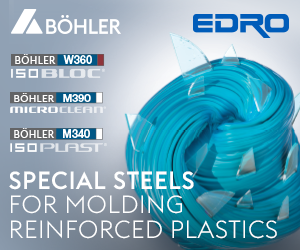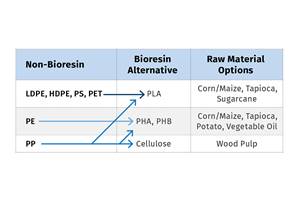Clariant Examines the Role of Color in a 'Circular Economy'
Top Clariant pigment expert sums up color compatibility with the plastics circular economy with a focus on packaging.
As is the case with other materials and additives suppliers on which I report on in a K 2019 preview article in our upcoming September issue, Clariant is sharing its views on some of the issues facing the plastics industry as it embraces the ‘Circular Economy.’
Philippe Lazerme, one of Clariant’s top pigment experts and head of marketing segment plastics at business unit pigment, sums up color’s compatibility with the plastics circular economy. He considers the challenges of designing for recycling and the specific issues of colorant choice for mechanical, chemical and organic recycling technologies. With a focus on packaging, he touches on some of Clariant’s latest products and collaborations advancing the shift.
When it comes to packaging, the company strongly believes that the necessary emphasis on recyclable plastics, re-using the resins and biodegradation shouldn’t mean saying goodbye to the vibrant colors and eye-catching designs consumers expect. Here then is Lazerme’s main points on how the industry can make color compatible with ‘circular economy’.
▪ The primary target of the “Circular Economy for Plastics” is that plastics should never be found as a waste in the environment. There are different ways to achieve this, starting from the proper design of the plastic article through efficient collection and sorting of the various polymers to recycling and reintroduction into the life cycle. Additionally, the use of bio-degradable polymers offers further possibilities.
▪ Top fast-moving consumer goods companies and plastic packaging producers representing over 20% of the global packaging market have committed to making 100% of their plastic packaging reusable, recyclable or compostable by 2025. No doubt that color will continue to play a key role in the packaging world. But the selection of the right colorants will be crucial.
Let’s go through the various parts of the cycle and show how a pigment and polymer soluble dye producer can help the stakeholders combine the need for color and the equally important need for sustainability:
▪ Design for recycling. Everything starts with the designer of the packaging. The task is to create packaging that is appealing, enhances the brand image, provides a differentiation and that can be properly recycled and reused as resin for new plastic products.
Depending on the recycling technology (mechanical, chemical), the choice of the colorant will be different. The designer needs to know which processing steps the article will be facing, not only for its production but also for its time after usage. This will influence the selection of the pigments. There will also be switch of polymers and changes in the composition of the packaging.
Since the brand owners have committed to incorporating significant amounts of recyclates in their new packaging articles there will be a further challenge to achieve brilliant and appealing colors.
Clariant Pigments is working on solutions to these challenges, such as faster and easier color matching with recycled resins or setting up a pigment range that can withstand various recycling loops without decomposing and remaining safe for future applications and for the working environment.
Reuse is another aspect of sustainability. In this case the colorant selection also requires a particular attention since it has to remain appealing and safe. The color should not fade out for the product to keep its appearance even after numerous reuses. High light-and weather fastness are key criteria.
The safety aspect is even more important, especially when we talk about bottles for drinks. The pigments should not migrate into the drink after the bottle has been washed many times with hot water containing strong detergents, for instance.
Clariant’s pigment portfolio offers a wide range of solutions.
▪ Recycling: There three major methods are mechanical recycling; solvent-based recycling; and, chemical recycling (depolymerization, pyrolysis, gasification).
Whatever the process is, proper recycling starts with proper collection and sorting of the plastic waste. In an optimal sorting center plastic is automatically sorted through different stages according to polymer types and color using Near Infra-Red (NIR) technology. It can separate the plastics according to their type, e.g. LDPE, HDPE, PP, PET, PS streams.
To work properly this technology requires a minimum amount of energy to be reflected to the sensor. It becomes a problem if the plastic part absorbs the NIR energy instead of reflecting it. The issue arises with plastics colored with a carbon black pigment. Carbon black absorbs in the NIR range which means that plastic articles colored with carbon black will not be identified during the sorting process and thus cause much trouble in the further recycling steps or end up in landfill.
Clariant has developed three colorants which can reflect in the NIR spectrum and will allow the plastics industry to still produce black articles which can be sorted properly. These grades can be used for HDPE, LDPE, PP, PET, PS, PA and PVC.
▪ Mechanical recycling: This is currently by far the most used process—80% of plastics collected for recycling are mechanically recycled.
Currently, mechanical recycling works relatively well for PET bottles, but for other polymers or mixed plastics it faces some limitations, at least for premium quality recyclates. After a few recycling loops the polymer properties have declined so much that it will become very difficult to re-use the recyclates.
There is also a need for a better understanding of the colorant behaviors after multiple recycling loops.
It is extremely important to ensure that the pigments and polymer soluble dyes used for the coloration of the collected resins will not decompose or generate any toxic substances during the compounding process.
Some pigment chemistries are more stable than others in terms of heat stability or migration behavior. However, it will require intensive work to select a safer range of pigments to be used to color plastic articles intended to be recycled. Because an organic pigment is often not only one single molecule; depending on the production process there might be other substances which could have a negative influence on the toxicological profile.
This is where a pigment producer with long experience and expertise in product safety and records can support the industry, brand owners, packaging processors and masterbatch producers. Clariant is already focusing attention in this direction.
A further challenge is the base color of the recyclate coming from the recyclers. It can be any kind of grey from a light, a dark or a brownish one. The re-coloration of these recycled polymers becomes an issue for the masterbatch producer. There are strong quality variations between the different recyclers.
To ensure a faster and constant color matching Clariant Pigments, together with a software provider, is developing a calibration set that will allow easy corrections for the base tone of the resin. This will be a major improvement to enhance the usage of post-consumer recyclates (PCRs).
▪ Chemical recycling: This can be viewed as a complementary technology, which will extend the offer of recycled resins in a quality that can meet the requirements of the packaging industry. There are different types of chemical recycling, but they are all currently at an emerging stage.
A solvent based process is a mix between chemical and physical recycling. It involves a solvent that will specifically dissolve a certain type of polymer. Practice shows that some residues remain in the polymer, and even the colors haven’t fully been extracted. The recyclate looks greyish. Further research work is needed. Especially one aspect that should be investigated is to find out which type of pigment chemistry will better be removed from the polymer. This is a long-term project.
Another type of chemical recycling is “depolymerization” which breaks the molecular bonds into the initial monomers. There are different technologies to achieve this: using enzymes or catalysts.
Pyrolysis or gasification are further methods to decompose a polymer and generate fuels that can be used to then produce new plastics.
For the colorant and masterbatch or compounding industry, chemical recycling would be the ideal way since the recycled resin will look very much like a virgin polymer and can thus be colored just like a virgin resin.
▪ Biodegradability Although still a small market, bio-degradable polymers enjoy increasing attention from brand owners and packaging companies.
Not every pigment can be used to color bio-degradable polymers, because they must comply with very strict standards in terms of impurities.
Clariant Pigments has set up a range of 26 organic pigments from its Graphtol and PV Fast product line fulfilling the requirements of the European Norm EN 13432. They cover the whole color spectrum and therefore provide valuable support to masterbatch producers and designers in extending color horizons for biodegradable plastics.
▪ Steps in the right direction Developments like these in the field of colorants contribute to advancing a closed loop for plastic packaging. As the necessary focus on re-use and recycling gains momentum, color will not pose a challenge to the technologies, to the efficient, viable recovery of plastic waste, and creation of high-quality PCR, but instead work in harmony towards the goal of achieving a Circular Economy for Plastics.
Related Content
PHA Compound Molded into “World’s First” Biodegradable Bottle Closures
Beyond Plastic and partners have created a certified biodegradable PHA compound that can be injection molded into 38-mm closures in a sub 6-second cycle from a multicavity hot runner tool.
Read MoreCling Wrap Made from Potato Waste
Australia’s Great Wrap to expand into U.S. with home compostable cling wrap and its refillable dispenser made from recycled PET bottles.
Read MoreWhy Are They Blending Biopolymers?
A sit-down with bioplastic producer Danimer Scientific showed me there are more possible answers to that question than I had previously thought.
Read MoreHow to Optimize Your Molds and Hot Runners for Processing Bioresins
Demand for bioresins is growing in molded goods, particularly as a sustainability play to replace fossil-fuel based materials, but these materials are not a drop-in replacement for traditional materials. Molds and hot runners need to be optimized for these materials.
Read MoreRead Next
Lead the Conversation, Change the Conversation
Coverage of single-use plastics can be both misleading and demoralizing. Here are 10 tips for changing the perception of the plastics industry at your company and in your community.
Read MorePeople 4.0 – How to Get Buy-In from Your Staff for Industry 4.0 Systems
Implementing a production monitoring system as the foundation of a ‘smart factory’ is about integrating people with new technology as much as it is about integrating machines and computers. Here are tips from a company that has gone through the process.
Read MoreAdvanced Recycling: Beyond Pyrolysis
Consumer-product brand owners increasingly see advanced chemical recycling as a necessary complement to mechanical recycling if they are to meet ambitious goals for a circular economy in the next decade. Dozens of technology providers are developing new technologies to overcome the limitations of existing pyrolysis methods and to commercialize various alternative approaches to chemical recycling of plastics.
Read More







 (2).jpg;maxWidth=300;quality=90)






















